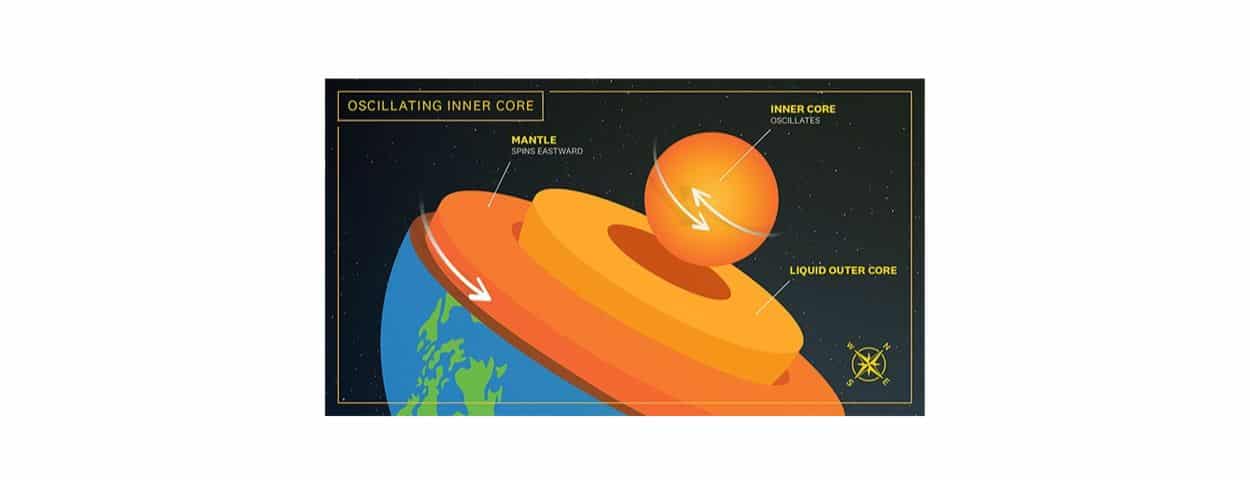(CN) — Researchers from the University of Southern California released a study Friday that suggests that the inner core of the Earth oscillates, which could explain the variation in the length of a day.
The findings, published in the journal Science Advances, detail how this new model of Earth’s inner core differs from earlier accepted models.
The previous models suggested that Earth’s inner core rotated, meaning moved in a circle. This new research conducted by seismologist John Vidale of USC Dornsife and researcher Wei Wang suggests that the inner core moves back and forth in oscillation.
“From our findings, we can see the Earth’s surface shifts compared to its inner core, as people have asserted for 20 years,” Vidale said in a statement. “However, our latest observations show that the inner core spun slightly slower from 1969-71 and then moved the other direction from 1971-74. We also note that the length of day grew and shrank as would be predicted.”
The data point to the inner core of earth oscillating instead of rotating.
“The coincidence of those two observations makes oscillation the likely interpretation,” Vidale said.
To perform their research, Vidale and Wang studied data that had analyzed waves formed by Soviet underground nuclear bomb tests that took place in the early 1970s. The pair’s findings came after they compared a set of earlier atomic tests that took place beneath Amchitka Island at the tip of the Alaskan archipelago in 1969 and 1971.
The researchers measured “compressional waves” that resulted from the two nuclear explosions and found that in that time Earth’s inner core had reversed direction.
“The idea the inner core oscillates was a model that was out there, but the community has been split on whether it was viable,” Vidale said. “We went into this expecting to see the same rotation direction and rate in the earlier pair of atomic tests, but instead we saw the opposite. We were quite surprised to find that it was moving in the other direction.”
The study also supports the idea that the oscillation varies based on the length of a day and geomagnetic fields, which Vidale believes will provide a compelling theory to be dissected by the research community.
One of those unknown questions researchers are hoping to answer is how Earth’s inner core, which is a hot ball of iron the size of Pluto and surrounded by a liquid outer core, formed in the first place.
“One of the questions we tried to answer is, does the inner core progressively move or is it mostly locked compared to everything else in the long term? We're trying to understand how the inner core formed and how it moves over time this is an important step in better understanding this process,” Vidale said.
Despite the interesting findings, the study's authors noted that further research will depend on being able to compare equally precise observations against their results. In an interview, Vidale explained why such data is hard to collect.
“Changes in the inner core, whether it is rotation of the inner core as a whole or local changes in the surface or the interior, only appear as changes in the timing of at most a few tenths of a second in seismic waves that are quite small and complex. Thus, the source of the seismic energy to be compared must be nearly an exact repetition months to years apart,” Vidale said.
Without more data from atomic tests, researchers will have to turn to other data collection methods, some of which are not as reliable.
“We can study earthquakes that repeat as well as these old nuclear tests, but they produce far weaker signals, requiring more of a patchwork of guesses about the geographical area of the inner core that is changing. There are also some new techniques that look for correlations in the background seismic noise with potential to help, although their resolution so far is not nearly good enough,” Vidale said.
Subscribe to Closing Arguments
Sign up for new weekly newsletter Closing Arguments to get the latest about ongoing trials, major litigation and hot cases and rulings in courthouses around the U.S. and the world.









